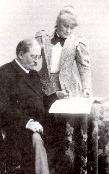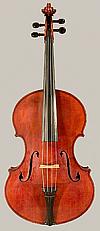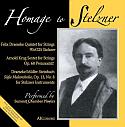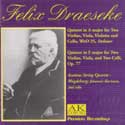FELIX DRAESEKE: Quintet in A major for 2 Violins, Viola, Violotta and Cello, WoO 25, Stelzner
|
Program notes prepared by Alan Krueck for the premiere recording of Draesekes A major Quintet on original Stelzner Instruments for AK/Coburg Recordings. |
|
Felix Draeseke was born in 1835 in the Franconian ducal town of Coburg, Germany. He was attracted to music early in his life and encountered no family opposition, when in his teens, he declared his intention of becoming a professional musician. Some years at the Leipzig Conservatory benefited him little, but after an early production of Wagner's Lohengrin, he was won over to the aesthetics of the New German School. He visited Franz Liszt in Weimar in 1857 (arriving after the departure of Joachim Raff) and the city became something of a focal point for him. Following the debacle of Peter Cornelius' opera The Barber of Baghdad and its consequences for Liszt and his circle, Draeseke wandered about Germany for a time before making his way to Switzerland in 1862, where he remained until 1876, teaching in the area around During his career Draeseke divided his energy almost equally among compositional forms. Already with his early Piano Sonata in C# minor, Op. 6 (Sonata quasi fantasia) of 1862-67 he aroused major interest, winning Liszt's unreserved praise of it as one of the most important piano sonatas after Beethoven. His operas Herrat (1879, originally Dietrich von Bern) and Gudrun (1884, after the medieval epic of the same name) met with considerable success, but subsequent neglect has kept posterity from recognizing Draeseke as a true successor to Wagner, and one of the very few capable of dramatically convincing and musically compelling examples of Gesamtkunstwerk. A master contrapuntist, Draeseke reveled in choral music, achieving major recognition through his B minor Requiem of 1877-80, but nowhere proving more convincingly his powers in this direction than in his Mysterium Christus, comprising a prolog and three separate oratorios and requiring three days for a complete performance; the work occupied him between 1894-99, but its conception stretches back to the 1860s. Of all the symphonies from the second half of the 19th century which are today neglected, Draeseke's Symphonia Tragica (Symphony No. 3 in C major, Op. 40) is one of very few which deserve repertory status alongside those of Brahms and Bruckner, for it is a masterful fusion of intellect and emotion, of form and content. Orchestral works like the Serenade in D major, Op. 49 (1888) or its companion of the same year, the symphonic prelude after Kleist's Penthesilea, have in them all that is deemed necessary for audience success: rich melodic invention, rhythmic vivacity and extraordinary harmonic conception. Draeseke's output was equally rich in chamber music and it is there in recent years that the composer has most easily attracted renewed interest. Reissues of the score and parts for the B flat Clarinet Sonata, Op. 38, the three string quartets (C minor, E minor and C# minor), the F major String Quintet (two celli), Op. 77 as well as the first publications by Wollenweber Verlag Munich of the 2nd Sonata for Viola alta and Piano (WoO 26) and the "Stelzner" Quintet in A major for Strings (with violotta), WoO 25 have attracted worldwide attention. Felix Draeseke already had his three string quartets behind him when he composed his String Quintet in A major, WoO 25 for two violins, viola, violotta and cello, his first attempt in the genre string quintet. Why Draeseke became interested in the Stelzner's violotta is explained partially by the fact that in May, 1896 the Dresden Conservatory sponsored a prize competition with the intent of giving Stelzner's instruments, particularly the violotta and cellone, some validity. Perhaps it was this competition which called Draeseke's attention to the violotta. It is also possible that Draeseke knew Stelzner personally, since Stelzner's business office was located in Dresden. According to his Lebenserinnerungen (Memoirs, 1904-11, unpublished) Draeseke undertook the composition of his violotta quintet simply out of joy at the sound of the new instrument, which is easy to understand because five years previously Draeseke had composed the first of his two sonatas for Hermann Ritter's viola alta and piano, another instrument no longer in use today. Already at the end of 1897 Draeseke, now somewhat hard of hearing, was able to attend the premiere of the Stelzner Quintet in the hall of the Dresden Musenhaus during the second chamber music evening under the patronage of the well-to-do Rappoldi family. A certain Gustav Naumann played the violotta part, and one assumes that all the other instruments were Stelzner design: that being the case, this recording preserves the piece exactly the way Draeseke and his audience first heard it, for the Summit Chamber Players utilize only Stelzner instruments. It is reported that the work was well received, though it remained in manuscript until 2005. It was played a number of times after Draeseke's death, but usually with normal instruments and a second cello being substituted for the violotta, a tradition based on the fact that Draeseke uses the tenor clef in his notation of the violotta in his manuscript score and parts. In this guise it has been recorded for AK/Coburg CD DR 0004, coupled with Draeseke's later String Quintet in F major for two violins, viola, and two celli, Op. 77. Quintet in A major for 2 Violins, Viola, Violotta and Cello, WoO 25, Stelzner
The first movement of the Stelzner Quintet (A major, 4/4, Much measured in stride, with fire) begins with a single introductory bar before the violotta brings in the very lyrical 8 measure main theme. Its melodic outline is colored by a shimmering eighth note accompaniment and is then taken over and repeated by the first violin. A darkening of harmony signals the entrance of a secondary theme characterized by triplets and a tendency to the minor. A march-like third theme (With fire) follows immediately and leads to the first climax. A few measures of transition bring the obligatory repeat of this exposition. The development section begins in D minor with the main theme presented on cello. Together with the third theme this melody is developed with intensity and driven to the heights until elements of the second theme take over the movement of ideas, and with ascent from below the main theme, intoned first by the violotta and then shared among the other instruments, is pushed to extremes of the violins as A major returns and, with it, the beginning of the recapitulation - a moment of exceptional beauty. The recapitulation itself is somewhat peculiar because the presentation of materials gives the themes an almost new caste, for it is here in the movement that Draeseke's highly individual sense of harmony emerges strongly. After the potential in the third theme makes yet another climax possible, an unstable A-flat major suddenly appears, and once again the violotta brings back the main theme. After re-establishing the movement's main key the composer requires a unison statement of the main theme on G strings of both violin and cello, the effect of which on the listener is immediate and prolonged. Elements of the secondary theme return and the movement is brought to a tumultuous end. The second, slow movement (F major, 3/8, Gently moving, measured) contains within a most moving inward nobility. The materials of the movement seem everywhere so simple, but with each repetition of a motive a gem glimmers in the harmonic and contrapuntal juxtapositions. As in the first movement, a lyrical main idea is presented by the violotta. The melody is immediately developed at the extreme heights of the instruments and then gently terminated when a strange 32 note motion conducts the movement to its second lyrical theme, which is easily recognized by rhythmic displacement and chromatic decoration. One must admit that Erich Roeder was right when he maintained (biographical study) that, "In constantly novel contrapuntal and harmonic trappings the thematic elements are treated as if almost in a rondo. The second theme also receives heightened expression by way of the violotta part and the highest tones of the violin." Particularly memorable is the end of the movement with its chromatic farewell to the main theme. There is little doubt that when listening to this quintet for the first time the Scherzo (A minor, 2/4, Quickly and lightly moving; Trio, G major, 6/8, approximately the same tempo, grazioso) is the movement which attracts the listener's attention immediately. And that is as it should be, for a reserved smile might be expected in considering Draeseke's unconventional handling of conventional form. The movement begins with a piquant pizzicato motive without involvement of the violotta, but after a quick eight measures and the beginning of bowed entries this is broken off to introduce a new melodic idea. Twelve more measures and all is repeated, after which the music is developed merrily onward with trade-offs between pizzicato and bowed elements, key changes and rhythmic accentuations until a sustained d minor chord in piano reveals the entrance of the triplets which are the basis of the Trio. Then on with the merriment, as twice the triplet material is extended from the viola range to the extremes of the violins. The transition to the repeat of the scherzo proper is recognized immediately when the triplets disappear in the bass and the sound of pizzicati is perceived. But this repeat is not as one might expect, for a little ostinato spook in the viola makes itself heard and heightens the humor behind the somewhat truncated scherzo repeat. The Finale (A major, 2/4, Quick and lively) is a rondo full of sunlight and the joy of creativity. The rhythmic main theme consists primarily of dotted 16th notes and after its A major exposition is treated to a canonic episode in F major. Immediately thereafter a sprightly dance-like secondary theme is presented by the violotta and developed until the entire ensemble busies itself with yet a third thematic element in which trills play a motivic role. What is required of the violins at this point is nothing less than extreme virtuosity! With the return of the main theme our beloved contrapuntist steps forth, applying canon and fugue until the second theme is further engaged. The playing grows almost symphonic as Draeseke lets loose with an exciting play of sonorities. Following this episode, against a background of the rondo's main theme, Draeseke recalls the main idea of the slow movement - a gesture often encountered in his sonata-form works. A last sounding of the main theme with a rapid 32nd note downward run in the violotta and cello brings the final chords in this admirable and highly idiosyncratic Stelzner Quintet of Felix Draeseke. |
|
|
|
Felix Draeseke wurde in der fränkischherzoglichen Stadt Coburg geboren. Von der Musik früh angezogen, erfuhr er keinen Widerstand der Eltern, als er sich im Jugendalter dazu entschied, sich beruflich darin auszubilden. Mehrere Jahre im Leipziger Konservatorium halfen ihm wenig, aber nach einer der frühen Aufführungen von Wagners Lohengrin überzeugte ihn die Ästhetik der Neudeutschen. Er besuchte Liszt in Weimar, wohin er 1857 zog, nachdem Joachim Raff die Stadt verlassen hatte. Nach dem Aufruhr um die Uraufführung der Oper Der Barbier von Bagdad von Peter Cornelius und dessen Konsequenzen für Liszt und seinen Kreis, siedelte Draeseke in die Schweiz über, wo er in der Gegend um Lausanne in der Suisse Romande Musik unterrichtete und bis 1876 blieb. Bei seiner Rückkehr nach Deutschland wählte Draeseke Dresden als Wohnort, wo er bis zu seinem Tod 1913 lebte. Obwohl er schon bei seiner Ankunft in Dresden als Komponist erfolgreich war, erhielt er erst 1884 eine Stelle am Dresdner Konservatorium und damit eine gewisse finanzielle Sicherheit. Zwei Jahre nach seiner Ernennung zum Professor am königlichen sächsischen Konservatorium heiratete Draeseke 1894 im Alter von 58 Jahren seine ehemalige Schülerin Frida Neuhaus. Allem Anschein nach war die Ehe bis zu seinem Hinscheiden durchaus glücklich und harmonisch, ein Segen für beide.
Während seiner Laufbahn teilte Draeseke seine Schöpferkraft fast gleichmäßig unter die verschiedenen musikalischen Gattungen auf. Schon mit der frühen (und einzigen) Klaviersonate Cis-moll, Op. 6 (Sonata quasi Fantasia, 1862-67) erweckte er großes Interesse und gewann dafür Liszts unbeschränkte Bewunderung, der sich stets darüber äußerte, die Sonate sei eine der bedeutendsten Klaviersonaten seit Beethoven. Seine Opern Herrat (1879, ursprünglich Dietrich von Bern genannt) und Gudrun (1864, nach dem gleichnamigen Epos des Mittelalters) wurden mit Erfolg aufgeführt, aber ihre darauffolgende Vernachlässigung nach der Jahrhundertwende hat die Nachwelt daran gehindert, Draeseke als einen der wenigen Nachfolger Wagners anzunehmen, die dramatisch überzeugende und musikalisch unwiderstehliche Beispiele des Gesamtkunstwerks schaffen konnten. Als Meister des Kontrapunkts machte es ihm Freude, sich immer wieder dem Chorsatz zuzuwenden, was sich in dem zwischen 1877-99 komponierten H-moll Requiem beweisen läßt, welches ein Haupterfolg zu Lebzeiten wurde. Nirgends aber zeigten sich seine Kräfte in dieser Kunstrichtung besser als in den überwältigenden Mysterium Christus, das einen Prolog und drei Oratorien enthält und drei Abende zur vollständgen Aufführung braucht: ein Werk, dessen Niederschrift zwischen 1894-99 fällt, aber dessen Planung bis in die 60er Jahre zurückreicht. Von allen vernachläßigten Sinfonien, die aus der zweiten Hälfte des 19. Jahrhunderts stammen, gehört Draesekes Symphonia Tragica (Sinfonie Nr.3 in C-dur, Op.40) zu den wahrhaft wenigen, neben den Sinfonien von Brahms und Bruckner, die in das Repertoire aufgenommen werden sollten, denn sie ist eine meisterhafte Fusion von Intellekt und Gefühl, von Form und Inhalt. Orchesterwerke wie die Serenade in D-dur, Op. 49 oder vom selben Jahr (1888) das symphonische Vorspiel nach Kleists Penthesilea, enthalten alle musikalischen Bedingungen des Publikumserfolgs: Reichtum melodischen Einfalls, rhythmische Vitalität und außerordentliche harmonische Ideen. Zahlreich sind auch seine großartigen Kammermusikwerke. Diese zählen heute zu den meistaufgeführten Kompositionen des Meisters, eine Entwicklung, die durch Neudrucke der Partitur und Stimmen für die B-dur Klarinettensonate (1887), der beiden Sonaten für Viola alta und Klavier (C-moll und F-dur, die zweite davon sogar im Erstdruck), einer Cello-Sonate, der drei Streichquartette (C-moll, E-moll und Cis-moll), des F-dur Streichquintetts (mit 2 Celli) und des Erstdrucks von dem hier vorliegenden A-dur Quintett für zwei Violinen, Bratsche, Violotta und Cello, WoO 25, Stelzner im Verlag Walter Wollenweber, München ermöglicht worden ist.
Quintett in A-dur für 2 Violinen, Bratsche, Violotta und Violoncello, WoO 25 Stelzner
Der erste Satz des Stelzner-Quintetts (4/4, A-dur, sehr mäßig bewegt) fängt mit einem einleitenden Takt an, ehe die Violotta das achttaktige, sehr lyrische Hauptthema beginnt. Ihre Melodie wird von Achtelbegleitung schimmernd gefärbt und von der ersten Geige übernommen und wiederholt. Eine Verdunkelung der Harmonie signalisiert den Eintritt eines Seitenthemas, gekennzeichnet durch Triolen und einer Tendenz nach Moll. Darauf folgt ein marschartiges drittes Thema (mit Feuer) , und ein erster Höhepunkt wird erreicht. Einige Takte der Überleitung bringen die obligatorische Wiederholung der Exposition. Die Durchführung fängt in D-moll an, und zwar mit dem Anfangsthema im Cello. Mit Hilfe des dritten Themas wird die Melodie dramatisch intensiv bearbeitet und in die Höhe getrieben, bis Elemente des zweiten Themas die Bewegung übernehmen. Von unten herauf, von der Violotta-Stimme angeführt und steigernd unter die anderen Instrumente aufgeteilt, schwebt das Hauptthema in äußerste Höhen, bis A-dur zurückkehrt und damit die Aufnahme der Reprise. Die Schönheit dieser Stelle kann kaum mit Worten beschrieben werden! Die Reprise ist selbst eigenartig in der ständig neugestalteten Behandlung des Materials und hier, vor allem in diesem Satz, wird Draesekes kühner Sinn für Harmonie am stärksten hörbar. Nachdem das dritte Thema noch einen Höhepunkt ermöglicht, überrascht eine unstabile As-dur Passage und die Violotta bringt das Hauptthema nochmals zurück. Beim Erreichen der Haupttonart verlangt der Komponist ein Unisono von Cello und Geige auf der G-Saiten für das Hauptthema, ein Klang, der lange in Erinnerung bleibt. Elemente der Nebenthemen kehren zurück, und der Satz wird zu einem rasenden Abschluß gebracht.
Beim ersten Anhören dieses Streichquintetts ist gewiss das Scherzo (2/4, A-moll, rasch und leicht bewegt; Trio, 6/8 G-dur, ungefähr dasselbe Tempo, grazioso) der Satz, der die Aufmerksamkeit des Zuhörers sofort fesselt. Und das ist gut so, denn nachdenkliches Lächeln ist bei Draesekes ungewöhnlicher Ausführung der üblichen Form zu erwarten. Der Satz fängt ohne Violotta-Stimme an, mit einem pikanten Pizzicato-Motiv im Piano, was nach acht schnellen Takten beim gestrichenen Einsatz des ganzen Ensembles mit einem neuen thematischen Gedanken abgebrochen wird. Nach zwölf Takten wiederholt sich alles, und der Satz setzt sich in rascher Abwechslung von Pizzicato und Arco, verschiedenen Tonarten und rhythmischen Betonungen lustig fort bis zu einem langgehaltenen d moll Akkord im Piano und dem Einsatz der Triolen, die dem Trio zugrunde liegen. Und dann weiter mit der Heiterkeit, als das Triolen-Material zweimal von der Bratschenlage bis in Geigenhöhe weitergegeben wird. Der Übergang zur Wiederholung des Scherzos ist sofort zu erkennen, wenn die Triolen in der Baßlage schwächer werden und der Klang vom Pizzicato vernommen wird. Aber die erwartete Wiederholung wird getäuscht, da ein Ostinato-Spuk in der Bratsche hervortritt und den Witz des etwas verkürzten Teils erhöht. Das Finale (2-4, A-dur, rasch und leicht) ist ein Rondo voll Sonnenlicht und Freude am Schöpfen. Das rhythmische Hauptthema besteht hauptsächlich aus punktierten 16teln und wird sofort nach dem A-dur Anfang in eine kanonische Episode in F-dur verwickelt. Die Violotta zeigt ein leicht tänzerisches Motiv, entwickelt dies, bis sich das ganze Ensemble nur noch mit einem dritten Gedanken beschäftigt, bei dem Triller eine motivische Rolle spielen. Von den Geigen wird an dieser Stelle höchste Virtuosität verlangt! Beim Wiederholen des Rondothemas tritt der geschätzte Kontrapunktiker hervor. Kanon und Fuge werden angewendet, ehe ein weiteres Spiel mit dem zweiten Thema aufgenommen wird. Das Spiel wirkt beinahe symphonisch mit der erregenden Klangfülle, die Draeseke entfesselt. Nach dieser wilden Episode läßt Draeseke gegen einen Hintergrund des Rondothemas die Wiederkehr des Hauptthemas des langsamen Satzes erscheinen – eine Geste, der man bei Draesekes Sonatensatzwerken oft begegnet. Ein letztes Ertönen des Hauptthemas und ein fast solistischer 32tel Läufer nach unten für Violotta und Cello bringt uns zu den Schlußakkorden dieses höchst eigenartigen, aber bewundernswerten Stelzner-Quintetts von Felix Draeseke. © Alan H. Krueck |
| Draeseke's Stelzner Quintet on CD: | |
AK Coburg DR 0010 [CD]
The Summit Chamber Players playing on original Stelzner instruments. (Naomi Gjevre and Javier Pinell, violins; James Przygocki, viola; John Thomson, violotta; Barbara Thiem, cello; Richard Rognstad, cellone) Read more... AK Coburg DR 0004 [CD]
Acantus String Quartet-Magdeburg playing on conventional instruments (Wolfgang Hasleder and Megumi Makino, violins; Fridtjof Keil, viola; Nikolaus Gädeke, cello; Johannes Hartmann, cello) Read more... |
|
[Chamber Music] [Orchestral Music] [Keyboard Music] [Listen ] [Top]
© All contents copyright by the International Draeseke Society


 Der zweite Satz (3/8, F-dur, sanft bewegt, getragen) enthält eine ungemein edle Innigkeit. Der Stoff des Satzes erscheint überall einfach, aber bei jeder Wiederholung eines Motivs glitzert die harmonisch-kontrapunktische Bearbeitung wie ein Juwel. Wie im ersten Satz wird der lyrische Hauptgedanke durch die Violotta geliefert. Diese Melodie wird sofort weiterentwickelt und dann leicht abgerissen, als eine eigenartige 32tel Bewegung den Satz zu einem zweiten lyrischen Gedanken leitet, der sich durch rhythmische Verschiebung und chromatische Verzierung zu erkennen gibt. Man muß Erich Roeder (biographische Studie) recht geben, wenn er in seiner Beschreibung des Satzes behauptet „In immer neuer kontrapunktischer und harmonischer Verkleidung lösen sich die Gedanken rondoartig ab. Auch das 2. Thema erhält durch die Violotta Stimme und die höchsten Geigentöne gesteigerten Ausdruck.“ Besonders erinnerungswürdig ist der Ausklang des Satzes mit seinem chromatischen Abschied vom Hauptthema.
Der zweite Satz (3/8, F-dur, sanft bewegt, getragen) enthält eine ungemein edle Innigkeit. Der Stoff des Satzes erscheint überall einfach, aber bei jeder Wiederholung eines Motivs glitzert die harmonisch-kontrapunktische Bearbeitung wie ein Juwel. Wie im ersten Satz wird der lyrische Hauptgedanke durch die Violotta geliefert. Diese Melodie wird sofort weiterentwickelt und dann leicht abgerissen, als eine eigenartige 32tel Bewegung den Satz zu einem zweiten lyrischen Gedanken leitet, der sich durch rhythmische Verschiebung und chromatische Verzierung zu erkennen gibt. Man muß Erich Roeder (biographische Studie) recht geben, wenn er in seiner Beschreibung des Satzes behauptet „In immer neuer kontrapunktischer und harmonischer Verkleidung lösen sich die Gedanken rondoartig ab. Auch das 2. Thema erhält durch die Violotta Stimme und die höchsten Geigentöne gesteigerten Ausdruck.“ Besonders erinnerungswürdig ist der Ausklang des Satzes mit seinem chromatischen Abschied vom Hauptthema.
